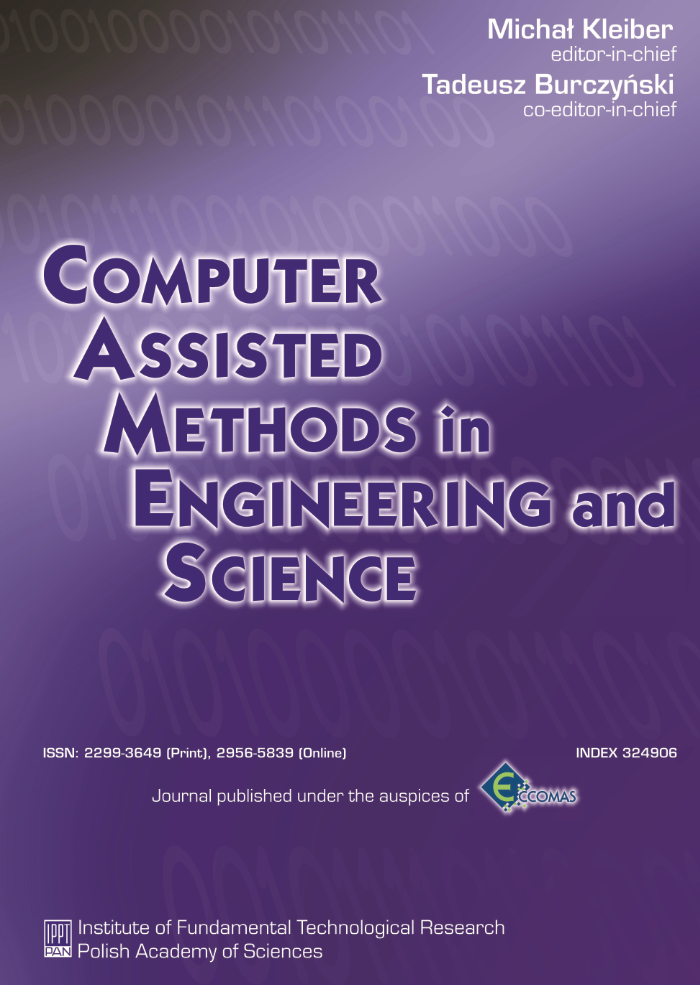Abstract
This paper presents an approach to optimize the structure of a micro-drill for reducing its lateral vibration, which has a strong effect on the quality of drilled holes during the cutting process. The micro-drill and the spindle of a micro-drilling spindle system are modeled as Timoshenko’s beam elements. Each element with five degrees of freedom at each node comprehensively includes the effects of continuous mass eccentricity, shear deformation, gyroscopic moments, rotational inertia with external thrust force and torque, and coupling torsional and lateral effect. The finite element method is used to determine the lateral amplitude response at the micro-drill point, which is considering the objective function during the optimization of the micro-drill by the interior-point approach. The diameters and the lengths of drill segments are chosen as the design variables with nonlinear constraints in the constant mass, mass center location, and torsional deformation of the drill. The in-house finite element code-integrated optimization environment is implemented in MATLAB to solve the optimal problem. The results showed that compared with the original micro-drill, the lateral amplitude response at the drill point of the optimal one is reduced by 91.89% at an operating speed of 50 000 rounds per minute (r/min), and its first critical speed and the corresponding amplitude response exceed those of the original one.
Keywords:
nonlinear constrained optimization, finite element analysis, micro-drilling spindle, continuous eccentricityReferences
[2] M.A. Alfares, A.A. Elsharkawy. Effects of axial preloading of angular contact ball bearings on the dynamics of a grinding machine spindle system. J. Mater. Process. Technol., 136(1): 48–59, 2003.
[3] J.R. Baker, K.E. Rouch. Use of finite element structural models in analyzing machine tool chatter. Finite Elem. Anal. Des., 38(11): 1029–1046, 2002.
[4] B.K. Choi, B.S. Yang. Multiobjective optimum design of rotor-bearing systems with dynamic constraints using immune-genetic algorithm. J. Eng. for Gas Turbines and Power, 123(1): 78–81, 2001.
[5] B.G. Choi, B.S. Yang. Optimum shape design of rotor shafts using genetic algorithm. J. Vib. Control, 6(2): 207–222, 2000.
[6] R.P.H. Faassen, N. Van deWouw, J.A.J. Oosterling, H. Nijmeijer. Prediction of regenerative chatter by modelling and analysis of high-speed milling. Int. J. Mach. Tools Manuf., 43(14): 1437–1446, 2003.
[7] V. Gagnol, B.C. Bouzgarrou, P. Ray, C. Barra. Stability-based spindle design optimization. J. Manuf. Sci. Eng., 129(2): 407–415, 2007.
[8] I. Griva, S. Nash, A. Sofer. Linear and Nonlinear Optimization. The Society for Industrial and Applied Mathematics, Siam, Philadelphia, 2009.
[9] M.Y. He, M. Kiemb, A.L. Tits, A. Greenfield, V. Sahasrabudhe. Constraint-reduced interior-point optimization for model predictive rotorcraft control. American Control Conference, 2088–2094, IEEE, 2010.
[10] Y.H. Kim, A. Tan, B.S. Yang, W.C. Kim, B.K. Choi, Y.S. An. Optimum shape design of rotating shaft by ESO method. J. Mech. Sci. and Tech., 21(7): 1039–1047, 2007.
[11] A.C. Lee, C.S. Liu. Analysis of chatter vibration in the end milling process. Int. J. Mach. Tools Manuf., 31(4): 471–479, 1991.
[12] A.C. Lee, C.S. Liu, S.T. Chiang. Analysis of chatter vibration in a cutter-workpiece system. Int. J. Mach. Tools Manuf., 31(2): 221–234, 1991.
[13] A.C. Lee, T.D. Hoang. Coupled lateral and torsional vibrations of the micro-drilling spindle systems. Int. J. Adv. Manuf. Technol., 87(5): 2063–2079, 2016.
[14] N. Olgac, M. Hosek. A new perspective and analysis for regenerative machine tool chatter. Int. J. Mach. Tools Manuf., 38(7): 783–798, 1998.
[15] A.O. Pugachev. Application of gradient-based optimization methods for a rotor system with static stress, natural frequency, and harmonic response constraints. Struct. Multidiscip. Optim., 47(6): 951–962, 2013.
[16] P. Pardalos, J.R. Birge, D.Z. Du, C.A. Floudas, J. Mockus, H.D. Sherali, G. Stavroulakis. Nonconvex Optimization and Its Applications, Springer, 1994.
[17] S.S. Rao, E.L. Mulkay. Engineering design optimization using interior-point algorithms. AIAAJ, 38(11): 2127–2132, 2000.
[18] S. Smith, T.P. Jacobs, J. Halley. The effects of drawbar force on metal removal rate in milling. CIRP Ann, Technol., 48(1): 293–296, 1999.
[19] Y.C. Shin. Bearing nonlinearity and stability analysis in high speed machining. J. Eng. Ind. ASME, 114(1): 23–30, 1992.
[20] H. Saruhan. Optimum design of rotor-bearing system stability performance comparing an evolutionary algorithm versus a conventional method. Int. J. Mech. Sci., 48(12): 1341–1351, 2006.
[21] W.R.Wang, C.N. Chang. Dynamic analysis and design of a machine tool spindle-bearing system. J. Vib. Acoust., 116(3): 280–285, 1994.
[22] B.S. Yang, S.P. Choi, Y.C. Kim. Vibration reduction optimum design of a steam-turbine rotor-bearing system using a hybrid genetic algorithm. Struct. Multidiscip. Optim., 30(1): 43–53, 2005.






